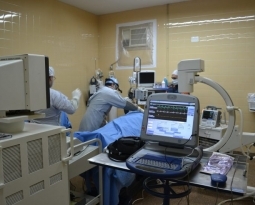Indiana Patent of the Month – September 2023
Thermwood Corporation, a US based, multinational, diversified CNC machinery manufacturer, has been advancing the industry for over half a century. In fact, in the 1970s, Thermwood was the first company to develop and offer for sale a CNC control system. This dedication to innovation has never ceased and the company has recently been breaking new ground in the realm of 3D printing, specifically in a process known as Fused Deposition Modeling (FDM) or Fused Layer Modeling (FLM).
Traditionally, 3D printing involves melting a thin filament of thermoplastic material and layering it to create the desired object. Thermwood has taken this concept to the next level by developing a novel method to optimize and revolutionize the additive manufacturing process.
Their approach starts with the fundamental slicing process that divides a computer-aided design (CAD) model into layers. While this is a standard procedure in 3D printing, Thermwood takes it a step further. They divide not only the CAD model into sections but also customize the print parameters for each section. This means that different sections of the same part can be printed with varying parameters, allowing for enhanced precision and efficiency.
Thermwood has innovatively reimagined how these sections are printed. Instead of completing one section before moving on to the next, they intersperse the printing of different sections. This strategic approach ensures that areas designed to fuse together are in perfect alignment, resulting in a more seamless and efficient printing process.
This method offers tremendous advantages in terms of time and material efficiency. Rather than relying on a slow, layer-by-layer printing process, this innovation allows for faster printing, making it feasible to manufacture larger parts or a greater number of items in a shorter time frame. By varying the print parameters for different sections, Thermwood’s approach enables the creation of complex objects with internal and external structures optimized for their specific functions. This means that intricate designs and intricate geometries can be realized with ease.
Are you developing new technology for an existing application? Did you know your development work could be eligible for the R&D Tax Credit and you can receive up to 14% back on your expenses? Even if your development isn’t successful your work may still qualify for R&D credits (i.e. you don’t need to have a patent to qualify). To find out more, please contact a Swanson Reed R&D Specialist today or check out our free online eligibility test.
Who We Are:
Swanson Reed is one of the U.S.’ largest Specialist R&D tax advisory firms. We manage all facets of the R&D tax credit program, from claim preparation and audit compliance to claim disputes.
Swanson Reed regularly hosts free webinars and provides free IRS CE and CPE credits for CPAs. For more information please visit us at www.swansonreed.com/webinars or contact your usual Swanson Reed representative.

















